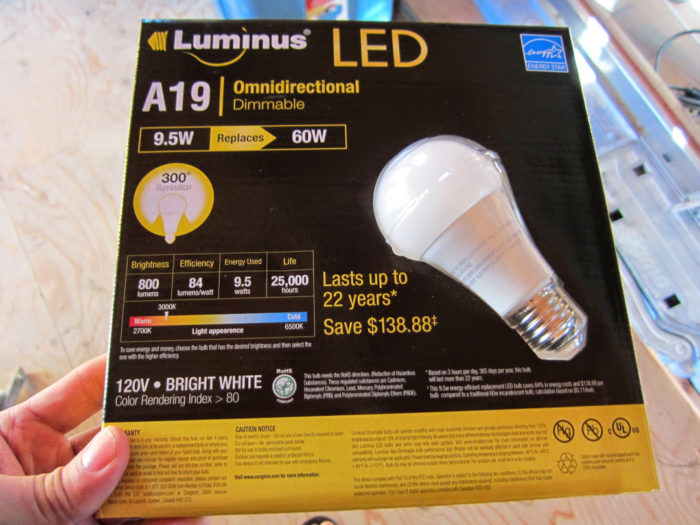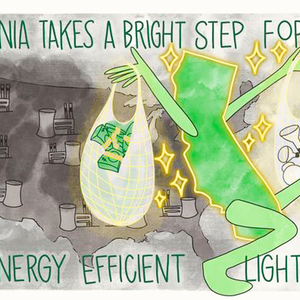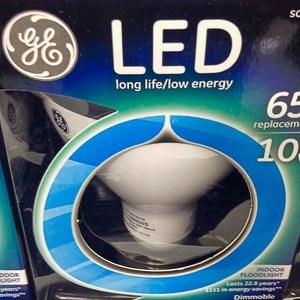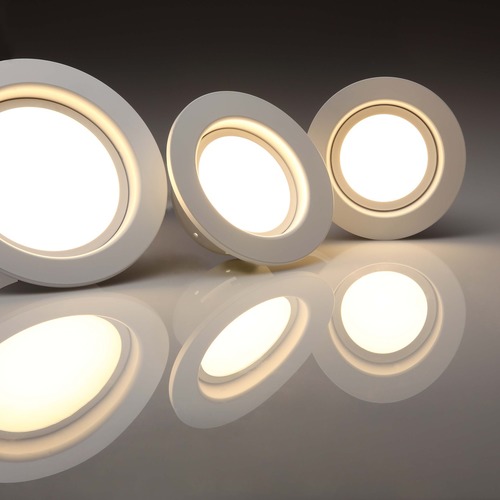
The Department of Energy (DOE) has taken the long awaited first step toward implementing the statutorily required phaseout of inefficient incandescent light bulbs. The phaseout was due to go into effect on Jan. 1, 2020 but was rolled back due to illegal actions taken by the Trump administration.
Each month of additional delay results in the ongoing sales of inefficient incandescent light bulbs costing consumers nearly $300 million in lost utility bill savings over the bulbs’ lifetime and result in another 800,000 tons of easily avoided carbon emissions, according to a recent analysis by the Appliance Standards Awareness Project (ASAP). In its written comments to the DOE docket, the lighting industry requested at least another full year of delay after DOE publication of a final rule even though that would cost U.S. consumers up to $3.4 billion and result in an additional 9.5 million metric tons of CO2. This is a price that neither consumers nor the environment can afford.
DOE is working to reinstate the minimum efficiency standards for everyday light bulbs, which by statute must meet a 45 lumen-per-watt (LPW) minimum, where lumens are the amount of light produced and watts the power consumed. The LED light bulbs that will replace the old incandescent and halogen bulbs work just as well, use up to 85% less power to deliver the same amount of light, and last a lot longer—10 to 25 years for LEDs compared to around a year for the most common types of incandescent bulbs.
In joint comments submitted in response to DOE’s Request for Information, the Natural Resources Defense Council (NRDC), ASAP, other leading efficiency advocates, and groups that represent consumers and low-income households urged the agency to:
- Implement the 45 LPW minimum standard without further delay.
- Reinstate the 2017 definition for general service lamps (i.e. everyday light bulbs) which added the bulbs that go into around 2 billion sockets into the scope of the regulations. These common bulbs include: 3-ways, candelabra and flame shaped bulbs, round globe bulbs, and the reflector bulbs that go into track and recessed lighting fixtures. (Note, exemptions for bulbs where an efficient alternative doesn’t exist, like the incandescent appliance bulbs used in an oven, were left in place.)
- Deny requests by the lighting industry to delay enforcement of the standards for extended periods of time.
In a letter delivered to U.S. Energy Secretary Jennifer Granholm, we urged her to “explore every option” for ending the delays as soon as possible.
The market is ready
LED bulbs of virtually every shape, light output level, hue (warm white to cool white), and base type found in our homes are manufactured by a broad range of manufacturers and are widely available today at retailers, both in stores all across the country and on the internet. The photo shown above from a big box retailer is indicative of the variety of LED bulbs that are already on store shelves and offered today.
According to data from Apex Analytics, LED bulbs comprised 60% of all bulb sales in 2019, more than triple the sales share in 2015, just four years earlier.

The DOE national lighting efficiency standards are needed to complete the transition away from inefficient incandescent and halogen light bulbs, as they still represented more than a third of all bulb sales in 2019. California and Nevada, which were granted special regulatory treatment in the 2007 federal energy legislation, successfully implemented a 45 LPW standard on Jan. 1 2020 and Jan. 1 2021, respectively, and the statewide switch to LEDs went smoothly.
Timing and sell through of existing stock
Retailers and manufacturers have known since 2007 that the 45 LPW minimum standard was due to go into effect on Jan. 1, 2020 and after that date it would be illegal to offer incandescent or halogen bulbs for sale. As part of President Biden’s Executive Order and fact sheet issued on the first day of his term, DOE was instructed to undo the rollback of the light bulb efficiency standards, which provided the industry with additional warning that they wouldn’t be able to sell these inefficient bulbs much longer and should avoid stockpiling them.
Given the maturity and well-developed worldwide LED bulb supply chain, there will be plenty of manufacturing capacity to meet increased U.S. demand. For example, lighting manufacturers successfully met the increased demand for LED light bulbs in mid-2018 created by the phaseout of incandescents and halogen bulbs in all 27 countries that comprised the European Union and have a combined population of about 450 million (considerably larger than the U.S. population of 331 million). These same factories are poised to meet increased orders for the U.S. market caused by the standards.
The 2007 law that established the light bulb efficiency standards is based on a date of sale prohibition. In other words, after the phase-out date no more incandescents can be sold, regardless of when they were manufactured. This mechanism is unambiguous, fast acting, and discourages retailer stockpiling that would meaningfully delay the savings and benefits from the standards. In addition, enforcement is greatly simplified as any incandescent or halogen bulb on the shelf (or offered for sale on the internet) covered by the regulations after the effective date is illegal, period. No further investigation is needed to determine the date of manufacture or date of import.
The lighting companies are asking DOE to instead base their enforcement on the date of manufacture and are seeking two years from the date of publication of a final rule implementing the standard for retailers to sell through their existing inventory. This alternate mechanism not only further delays the benefits of switching to LEDs and vastly complicates enforcement, it’s not the path Congress chose.
It’s time for DOE to act
DOE has a non-discretionary legal obligation to implement the light bulb efficiency standards and we urge them to do so as soon possible and without further delay. The savings are massive and unlike most appliances where it may take 10 or more years for the installed stock to turn over, most incandescent light bulbs fail within a year or two under normal use—allowing the carbon and utility bill savings due to the standard to occur quickly.
The lighting industry has had notice of these changes for well over a decade. When Congress called for this transition, they did so because they knew it was right for the planet and right for consumers. DOE can’t let short-sighted corporate interests derail that now.
Noah Horowitz is director, Center for Energy Efficiency Standards, Climate & Clean Energy Program, at the Natural Resources Defense Council. This post was originally published at the NRDC Expert Blog and is republished here with permission.
Weekly Newsletter
Get building science and energy efficiency advice, plus special offers, in your inbox.















15 Comments
Just one more example of how much more efficient and effective it would be to have a carbon/environmental tax on the electricity used (vs regulating every use of electricity).
I worked in Energy Efficiency for over 10yrs and have to call out a number of false claims (and considerations based upon the application): 1. Most modern LED & CFL bulbs do not last more than 2yrs in real-world use (some fail in a blinking mode & some fail as far too dim). Neither filament nor fluorescent bulbs like to be power-cycled; it dramatically reduces their lifetime 3. Whereas filament bulbs can be installed in completely-enclosed fixtures, LED & CFL types will not tolerate this for long (they cannot dissipate enough heat). 4. LED & CFL bulbs do not like to be installed "upside down", or with their power-supplies facing upwards (if they are installed with their bases faced down, it will double to quadruple their working lifetimes).
P.S. To evidence the reliability of well-made and well-treated "Edison" filament bulbs, check the Livermore, CA firehouse for the bulb that burned for over 75yrs.
I am certainly for energy-efficiency when it makes sense, but I see far too many falsehoods repeated. The same goes for solar: PV panels can last for decades, but inverters and other supporting systems will not last nearly that long.
Please supply evidence most LED bulbs last < 2 years. I've installed dozens over the last decade and haven't come across that. Your claim implies I would have replaced all of them many times over. Many have been installed upside down too with no issues.
Also, an incandescent bulb that lasts 75 years and guzzles energy is neither economically or environmentally prudent. A free 40w incandescent bulb at $.13/kwh would be out of the money after about 333 hours vs. an LED, so you'd be burning money for every hour after that. Obviously, a 75-year light bulb wouldn't be free either.
Hello. I tried to reply to "Paul Wiedefeld", but it instead pointed me to Hank_W (I so apologize, if that is a mistake): If you have dozens of LED bulbs that have lasted a decade, I would be very curious as to the MFG's. If your LED bulbs have faired that well, especially if installed upside-down, are any in enclosed fixtures? Are you taking into consideration the true, non-subsidized cost of these bulbs (the LED bulbs installed in the White House cost >$60ea). We have tested CREE, Philips, Osram, & a number of lesser Chinese bulbs and all have lasted <4yrs without faults. My entire home is lit with LED, and many are DC fixtures recharged by day via solar (my low-voltage DC LED lights have proven quite reliable), so I can assure you that I want to believe in clean power. The facts just aren't quite there to support the majority of households being ready for "clean" energy. For the record, I was an early adopter (tester) of PV solar; I ran a CB rig in High School using a salvaged ~7W solar surplus solar panel (the interconnects of the panel were faulty, but I fortunately was able to repair many of them after having learned to solder at age 7). Yes, a 75yr filament bulb might seem expensive to run in the long run. But, please consider all of the costs of LED, CFL, & solar technologies; we have sadly become a throw-away society and this involves its own costs. I do hope for PV tech that exceeds 21% efficiency for consumer applications (satellite grade PV does hit 27-28%), but the engineering world considers anything below 30% to be a gross failure. I intend no disrespect and still wish to know what brands of AC-powered LED bulbs have proven so reliable for you.
Cree and Philips I believe. But I installed them in 2010 or so, so I might not be remembering correctly. If anything, seems like 11 years later they'd be even better. They're used daily and installed upside down in recessed cans, not enclosed. In terms of cost, I can buy 40w equivalent LEDs for a buck or two. No incandescent bulb can compete with that and I'd wager few CFLs could either. Or any power plant for that matter.
An incandescent that lasts 75 years guzzling energy is still "throwaway."
At this point, solar panel efficiency doesn't really matter, I don't know why people worry about it. They're cheap and reliable. That's what matters.
For whatever it's worth, in the six years I've lived in my new house, none of the three dozen or so LEDs have needed replacement. All but a few are upside down and most installed in low voltage fixtures specifically designed for halogen bulbs, not LEDs.
Thanks, Stephen. Your input is interesting and worthwhile. What brand/type were these, "three dozen or so", LED bulbs that have lasted 6yrs? That would be a great data point, and also might help other consumers.
Mostly Triangle Bulbs, from Amazon. They're about a third the price I paid when I bought them in 2015.
It's true that if you buy the cheapest junky LED light bulb from Amazon, it might not last even a week. But if you buy name brands like Philips, Cree, and Syvania/Osram, failures will be rare.
LED bulbs for enclosed fixtures and any orientation you want are now available.
It's true that you can make an incandescent lamp last more or less forever by running the filament at a low temperature. Unforunately, the efficacy drops precipitously when you do that. There's nothing about the manufacturing quality involved in making a super-long-life incandescent. It requires only a willingness to sacrifice efficiency and light output to get bragging rights for a long lasting bulb.
If you are worried about falsehood being repeated, check your own facts first.
Have checked all of my facts, thank you. While I welcome your input, I worked in the energy industry and have overseen many hours of testing. You are correct that cheap Chinese LED bulbs like, "Lights of America", are not to be trusted; but, I also have overseen real-world tests of Philips, CREE, Sylvania/OSRAM, and other quality bulbs. The quality LED bulbs certainly last longer, but all of those brands have suffered early failures in the field. To be fair, CREE did stand behind its product. If you are aware of consumer LED bulbs for U.S. fixtures that survive >5yrs in enclosed and/or upside-down sockets, please do share. I have seen hundreds tested and have not seen any meet their longevity ratings.
The fact that some small percentage of early failures occur with the good brands should not be confused with an expectation that they will die is less than 2 years. Similarly, if they are spec'ed at 25,000 hours, and they die at 15k hours in a lab test, that's disappointing and a problem, but it's disingenuous to equate that to lasting less than 2 years in consumer use.
From a quick look around my house, I have an one fully enclosed, base up fixture that's had the same LED A-lamp in it for at least five years with no problems, but it's not heavily used. I have one that's on a lot and switched at lot, fully enclosed, but horizontal orientation. And one that is base up, with a shade that's open on the bottom. My memory for specifics of what brands they are is not very good, but I could open them up and see if you want.
Although I support attempts to improve efficiency, and in general the notion of using regulation to do so, I do take issue with a couple points here:
>10 to 25 years for LEDs compared to around a year for the most common types of incandescent bulbs.
I often see this claim repeated, but the evidence doesn't seem to be there. Sure, an LED itself (the actual emitter) might last 50k hours or more before seeing significant degradation -- more if it can be kept cool -- but an LED bulb is a collection of electronic components, all with their own failure rates and mechanisms. If your LED bulb slowly loses brightness over time, to the point that you decide to replace it in 10 to 25 years because its light quality has diminished sufficiently, lucky you! But if your LED bulb just blinks off one day (or, like a couple of mine, sporadically blinks on and off), one of those other components (or some connection in the assembly) has failed, and you'll never see the theoretical lifespan of the LED emitter itself.
Component failures are exacerbated by high temperatures -- one rule of thumb suggests that every 10C increase in temperature halves lifespan. Because most LED bulbs are intended for existing fixtures, manufacturers are limited in how much thermal management they are able to include (also, larger heatsinks would add cost). Also, look closely at cheap LED bulbs -- many will state, in small print, limitations against use in enclosed fixtures or in certain positions (both related to thermal management), restrictions that I'm fairly certain that most people will not notice or pay heed to. (Component failures are also exacerbated by low-quality components and poor assembly, but that's always the case -- you don't get what you don't pay for.)
What this all boils down to is that LEDs have a theoretically long lifespan, but in practice I've seen my share of LED failures after only a couple years in service, just like incandescent bulbs. And, the manufacture and disposal around LED bulbs does raise some environmental concerns as well (though not as bad as mercury-filled fluorescents!)
>LED bulbs of virtually every shape, light output level, hue (warm white to cool white), and base type found in our homes are manufactured by a broad range of manufacturers and are widely available today at retailers
My complaint here is the difficulty in comparing bulbs, and in finding high-quality light. Color temperature is one thing, but overall spectrum (sometimes reflected in a CRI value) is another. (Note that even CRI can be gamed (or just lied about), but that's another rant.) Also, things like flicker come into play with light quality. Granted, some strides have been made -- at least lumens/watt, CRI, and color temperature are usually reported -- but more could be done (perhaps in the regulatory structure) to make light quality characteristics more available and trustworthy.
The TL;DR here is that yes, LED lights can be great. Yes, they are widely available, efficient, and can be found with very long lifespans and high quality light. However, the lower-cost end of the market (which is likely to be the most broadly adopted products) suffers from reduced lifetimes due to product quality & durability issues, leading to disposal / end of life concerns, as well as poor-quality or poorly-characterized light. I think these concerns (especially the lifecycle concern as it pertains to greenness) shouldn't be forgotten and we should strive to make *high quality* LEDs the goal, not just anything that says LED on the box.
I agree with you. I have installed A LOT of CFL and LED bulbs and 1 in 4 are faulty or fail within months. I started the movement of CFL bulbs as my former employer which was a very large retirement community. I dated the bulbs when I put them in. Interestingly on of the 1st CFL bulbs I put in became one of my last bulbs to change. I lasted almost 7 years of 24/7 use.
I'm going to call bull on the "about one year for... incandescent bulbs" as well. I remember the time before CFLs were introduced, and no way was I replacing bulbs at that rate. In a typical house that would mean replacing a bulb weekly.
+1 on life often not meeting the specs. And poor dimming performance is often an issue.
Log in or create an account to post a comment.
Sign up Log in